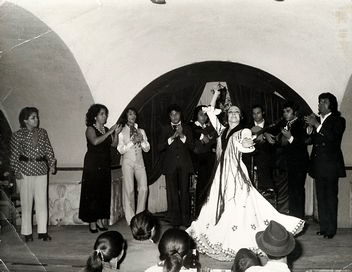flamenco
The Singing Cafés
A lot of artists saw the splendour and others the agony of the Singing Cafés between 1850 and 1920, approximately. These establishments with an Andalusian style had an ambiance of smoke and alcohol. Besides the flamenco a lot of different shows were performed in there. First, they illuminated these establishments with candles, then with oil lamps and later with gas lamps.

The Origin of the Tablaos; the Singing Cafés
A lot of artists saw the splendour and others the agony of the Singing Cafés between 1850 and 1920, approximately. These establishments with an Andalusian style had an ambiance of smoke and alcohol. Besides the flamenco a lot of different shows were performed in there. First, they illuminated these establishments with candles, then with oil lamps and later with gas lamps.
Barcelona, a Mediterranean city, due to its geographic location opened to commerce, to the constant immigration of Andalusian people or to the fact that is a welcoming city and a receptor of every foreign artistic manifestation was, along with Seville and Madrid, one of the cities in which appeared the first singing cafés and one of the places where the flamenco was venerated.
To get a good idea of how successful was the flamenco in Catalonia we need to look back to the XIX mid-century when, in the Romanticism, the 4th April 1847, the Liceo Grand Theatre was inaugurated in Barcelona. The same day the first singing café was opened in Seville, “El Burrero”, in the first Feria de Abril, created, curiously, by a Catalan, Narciso Bonaplata and a Vasc, José María Ibarra.
Lets focus in the famous stage of Liceo in Las Ramblas of Barcelona. The Spanish technique and the love for the Andalusian dances were trendy. For the inauguration they hired the Catalan dancer Juan Camprubí and the dancer Manuela García along with a group of dancers who performed “seguidillas manchegas”, “rondeñas”, “boleras” and “cachuchas”. Caixa de Barcelona reflects the passion that this couple aroused in the audience in the book “History of the dance in Catalonia” published in 1987:
French dances are all the same; five minutes after they start they caused the same effect than the chloroform. We want our Camprubí with his Sinfonía de Mercadante, his Malagueña, and his Spanish dances.
The billboard was renewed with famous international figures of the dance: Petra Cámara; Josefina Vargas; Pepita de Oliva; the famous Lola Montes, the Catalan dancer Rosita Mauri, who performed one of the main roles in the Paris Opera, and the famous dancer and choreographer Ricardo Moragas. Later, came the Golden period of the Spanish dance with Juan Magriñá and Rosita Segovia and all the great artists that accompanied them.
In Barcelona there were 74 singing cafés at the end of XIX century. The most famous were Café Sevillano, Villa Rosa, Café Concierto Barcelonés, Café Concierto Triana, Café del Puerto and Café de la Alegría which after 1887 changed its name for Edén Concert. In 1887 the dancer Faíco, the dancers María Pantoja and Juana Ortega or Estrellita Castro and Carmen Amaya, at the beginning of her career, along with the singer Fernando el de Triana succeeded there.
The most famous cafés of that time were:
Edén Concert
The ambiance of this establishment at the beginning of the XX century was the most selected of the city. The gentlemen used to meet at the exit of Liceo to show off in front of the ladies artists. In this time Barcelona had a lot of money and the shops and jewelleries of the district remained open the whole night. There were a few the ones who took advantage of the rich men and full of jewels and precious stones abandoned the staged overnight.
El Villa Rosa
The Singing Café Villa Rosa, was took in 1916 by the famous guitarist Miguel Borrull Castelló married with the dancer Lola Jiménez. It became one of the most prestigious of Barcelona. The family Borull is formed by his daughters the dancers Julia (model of Julio Romero de Torres), Concha and Isabel; his son Miguel, also a guitarist, father of the famous dancer Mercedes Borull, La Gitana Blanca; and his other daughter, Lola, who wasn’t an artist but was the mother of Trini Borull, who was main dancer in the Liceo Grand Theatre.
Apart from the family Borrull in that flamenco temple performed the best artists of the beginning of the XX century. During 1950 and 1960 the café was in decline by the management of Manuel Pantoja from Jerez under the name of Casa de Vinos Villa Rosa.
El Guiza danced there, a boozer dancer from Jerez who also sang when he was happily drunk. He performed in the show by La Chunga (who in 1970 inaugurated Tablao Cordobes, still open nowadays and the oldest tablao in Barcelona) and in different establishments of Barcelona for a fixed salary, as many others in that time. He was sick of discipline and schedules, he danced free and when you didn’t expect he came to the meetings in which he knew there would be a good tip. El Guiza mixed Russian folklore with bulería. He was not very orthodox but he fascinated a lot of learned spectators.
In 1954, Concha Borrull invited the dancer José de la Vega and the great dancer Leonor María, who was her pupil, to attend her school because she was going to receive a very important figure who came from the United States. The visitor was the famous dancer Eduardo Cansino, father of the cinematographic star Rita Hayworth. They danced sevillanas for him and at the end of the show the guitarist Miguel Borrull performed a soleá accompanied by the dancers.
A lot of artists saw the splendour and others the agony of the Singing Cafés between 1850 and 1920, approximately. These establishments with an Andalusian style had an ambiance of smoke and alcohol. Besides the flamenco a lot of different shows were performed in there. First, they illuminated these establishments with candles, then with oil lamps and later with gas lamps.
Barcelona, a Mediterranean city, due to its geographic location opened to commerce, to the constant immigration of Andalusian people or to the fact that is a welcoming city and a receptor of every foreign artistic manifestation was, along with Seville and Madrid, one of the cities in which appeared the first singing cafés and one of the places where the flamenco was venerated.
To get a good idea of how successful was the flamenco in Catalonia we need to look back to the XIX mid-century when, in the Romanticism, the 4th April 1847, the Liceo Grand Theatre was inaugurated in Barcelona. The same day the first singing café was opened in Seville, “El Burrero”, in the first Feria de Abril, created, curiously, by a Catalan, Narciso Bonaplata and a Vasc, José María Ibarra.
Lets focus in the famous stage of Liceo in Las Ramblas of Barcelona. The Spanish technique and the love for the Andalusian dances were trendy. For the inauguration they hired the Catalan dancer Juan Camprubí and the dancer Manuela García along with a group of dancers who performed “seguidillas manchegas”, “rondeñas”, “boleras” and “cachuchas”. Caixa de Barcelona reflects the passion that this couple aroused in the audience in the book “History of the dance in Catalonia” published in 1987:
French dances are all the same; five minutes after they start they caused the same effect than the chloroform. We want our Camprubí with his Sinfonía de Mercadante, his Malagueña, and his Spanish dances.
The billboard was renewed with famous international figures of the dance: Petra Cámara; Josefina Vargas; Pepita de Oliva; the famous Lola Montes, the Catalan dancer Rosita Mauri, who performed one of the main roles in the Paris Opera, and the famous dancer and choreographer Ricardo Moragas. Later, came the Golden period of the Spanish dance with Juan Magriñá and Rosita Segovia and all the great artists that accompanied them.
In Barcelona there were 74 singing cafés at the end of XIX century. The most famous were Café Sevillano, Villa Rosa, Café Concierto Barcelonés, Café Concierto Triana, Café del Puerto and Café de la Alegría which after 1887 changed its name for Edén Concert. In 1887 the dancer Faíco, the dancers María Pantoja and Juana Ortega or Estrellita Castro and Carmen Amaya, at the beginning of her career, along with the singer Fernando el de Triana succeeded there.
The most famous cafés of that time were:
Edén Concert
The ambiance of this establishment at the beginning of the XX century was the most selected of the city. The gentlemen used to meet at the exit of Liceo to show off in front of the ladies artists. In this time Barcelona had a lot of money and the shops and jewelleries of the district remained open the whole night. There were a few the ones who took advantage of the rich men and full of jewels and precious stones abandoned the staged overnight.
El Villa Rosa
The Singing Café Villa Rosa, was took in 1916 by the famous guitarist Miguel Borrull Castelló married with the dancer Lola Jiménez. It became one of the most prestigious of Barcelona. The family Borull is formed by his daughters the dancers Julia (model of Julio Romero de Torres), Concha and Isabel; his son Miguel, also a guitarist, father of the famous dancer Mercedes Borull, La Gitana Blanca; and his other daughter, Lola, who wasn’t an artist but was the mother of Trini Borull, who was main dancer in the Liceo Grand Theatre.
Apart from the family Borrull in that flamenco temple performed the best artists of the beginning of the XX century. During 1950 and 1960 the café was in decline by the management of Manuel Pantoja from Jerez under the name of Casa de Vinos Villa Rosa.
El Guiza danced there, a boozer dancer from Jerez who also sang when he was happily drunk. He performed in the show by La Chunga (who in 1970 inaugurated Tablao Cordobes, still open nowadays and the oldest tablao in Barcelona) and in different establishments of Barcelona for a fixed salary, as many others in that time. He was sick of discipline and schedules, he danced free and when you didn’t expect he came to the meetings in which he knew there would be a good tip. El Guiza mixed Russian folklore with bulería. He was not very orthodox but he fascinated a lot of learned spectators.
In 1954, Concha Borrull invited the dancer José de la Vega and the great dancer Leonor María, who was her pupil, to attend her school because she was going to receive a very important figure who came from the United States. The visitor was the famous dancer Eduardo Cansino, father of the cinematographic star Rita Hayworth. They danced sevillanas for him and at the end of the show the guitarist Miguel Borrull performed a soleá accompanied by the dancers.
